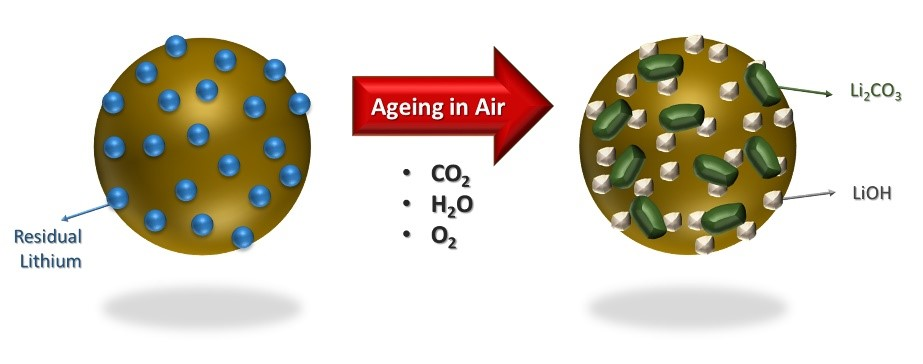Nov 19 2020
In the field of battery manufacturing, it is well known that several cathode materials are sensitive to moisture.
 The effects of ambient air storage on the surface of NMC-811. Image Credit: WMG, University of Warwick
The effects of ambient air storage on the surface of NMC-811. Image Credit: WMG, University of Warwick
But with the increase in acceptance of high-Ni-based battery parts, scientists at WMG, University of Warwick have discovered that the drier the surroundings in which these cathodes are stored and processed in, the more the improvement in the performance of the battery.
Globally, high-Ni batteries are progressively in demand, with more number of automotive companies exploring the application of high-Ni batteries for electric vehicles. But high-Ni cathode materials are vulnerable to instability and reactivity when exposed to humidity. Thus, it is critical how they are stored, to ensure ideal performance.
In a paper titled “The effects of Ambient Storage Conditions on the Structural and Electrochemical Properties of NMC-811 Cathodes for Li-ion batteries,” published in the Electrochimica Acta journal, scientists from WMG, University of Warwick suggest the ideal approach to store high-Ni cathodes to prevent premature degradation.
Scientists tested NMC-811 (high-Ni cathode material) by exposing it to various temperatures and humidities. Then, they measured the performance of the material and degradation in a battery across a 28-day period, examining them using a mixture of chemical, physical, and electrochemical testing. This comprised high-resolution microscopy to detect the chemical and morphological variations that happened at the micron and sub-micron scale when the batteries charged and discharged.
The storage settings require vacuum oven-dried, as exposed (to humidity), and a control measure. The team searched for surface contaminations, which include H2O and carbonates, and learned there were three processes that can cause impurities, such as:
- Residual contaminations originating from unreacted precursors during synthesis
- Contaminations created during ambient storage time
- Higher equilibrium coverage of surface carbonates/hydroxides (present to stabilize the surface of Ni-rich materials following the synthesis procedure)
They learned that under all circumstances (oven-dried and as-exposed), the cathode material displayed inferior first discharged specific capacity and cycling performance than the control. However, the as-exposed measure demonstrated that after 28 days of ambient moisture exposure, the H2O and CO2 react with the Li+ ions in the battery cell, causing the development of lithium carbonate and hydroxide species.
The development of oxides and carbonates on the surface of NMC-811 add to the loss of the electrochemical performance when materials age, because of the substandard ionic and electronic conductivity, in addition to the electrical isolation of the active particles.
This implies that they cannot reversibly store lithium ions anymore to transport “charge.” SEM analysis verified the inter-granular porosity and micro-cracks on these aggregate particles, after the 28 days of ambient exposure.
They can thus conclude that the driest surroundings, at dew points of about −45 °C, are the most ideal for storing and processing the materials, which could thus help deliver top battery performance. Humid conditions and exposure at junctions during the manufacturing process will result in the deterioration of the materials and components; this causes shorter battery service life.
Whilst moisture is well known to be problematic here, we set about to determine the optimal storage conditions that are required to mitigate unwanted, premature degradation in battery performance. Such measures are critical to improve processing capability, and ultimately maintain performance levels. This is also of relevance to other Ni-rich systems e.g., NCA materials.
Dr Mel Loveridge, WMG, University of Warwick
According to Professor Louis Piper from WMG at the University of Warwick, “Considerable global research effort will continue to focus on these materials, including how to protect their surfaces to eliminate risks of parasitic reactions prior to incorporation into electrodes. In the UK, leading research by the Faraday Institution has a project consortium entirely devoted to unraveling the degradation mechanisms of such industry-relevant materials.”
Journal Reference:
Busà, C., et al. (2020) The effects of ambient storage conditions on the structural and electrochemical properties of NMC-811 cathodes for Li-ion batteries Electrochimica Acta. doi.org/10.1016/j.electacta.2020.137358.